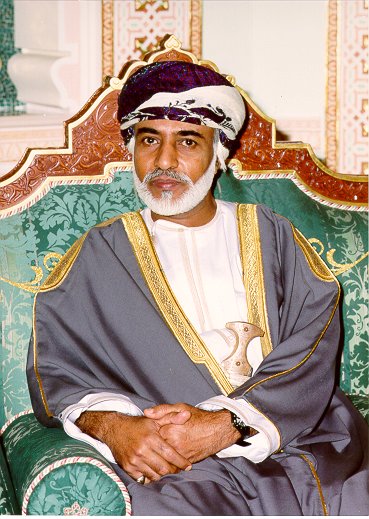The History of
The Sultanate of Oman

Emergence of Islam
Historians cannot give specific dates as to when Islam emerged in Oman, but documents indicate that the Prophet Mohammed (Peace Be Upon Him) contacted Oman's leaders in 6th Hegira (AH - from the Islamic calendar). The first Omani called to the Islamic faith was Mazin bin Ghaduba Al-Tay who declared that he had destroyed the idols and '..come before the Messenger and converted to Islam.' Following his revelation, Mazin travelled to the Prophet Mohammed (PBUH) and dedicated himself to the faith of Islam, to obeying its laws and to spreading the word of Islam to the unbelievers. The Arab Islamic Conquest continued from the time of the Prophet's death in 11th century AH for around 100 years. With Oman's strong merchant trading links, it was instrumental in spreading the word to other countries such as Persia.
In the 16th century AD, Oman was invaded by Portuguese troops, who were vying for control of the Gulf and the Indian Ocean. Their occupation lasted around 150 years until they were finally expelled by Sultan bin Saif al-Yarubi in 1650AD, the date which most consider to be the start of Oman's complete independence. The following Ya'aruba Dynasty brought a new-found renaissance to the country and it was during this time that many of the decadent forts and castles were built, some of which are still standing.
In 1718AD, the Imam, Sultan bin Saif II died and civil war broke out over the election of his successor. This war raged for the next 18 years and two factions emerged: one supporting the leadership of Saif bin Sultan, who was, at the time, a young boy; and the other supporting Muhanna bin Sultan who held the necessary qualities to be an Imam. Muhanna was smuggled into Rustaq Fort where he was thus established as Imam in 1719AD. He was not a popular leader, despite his hard work, and only one year later, Ya'arub bin Bal'arab forced him to concede his leadership and killed him. Ya'arub installed the young Saif bin Sultan as Imam and declared his own role as Saif's custodian. However, he abused his role and Bal'arab bin Nasir took over the welfare of Saif in 1723AD.
In 1738AD, a huge battle took place between Persian troops and the Arabian forces in Bahla. The Arabian forces were defeated and Imam Saif escaped to Buraimi where he declared his intention to fight and overthrow the Persians. However, unrest among the people, who now favoured Sultan bin Murshid as new Imam, gave the Persians the opportunity to capture Muscat. On the Persians' attempts to take over Sohar, Ahmad bin Said, the deputy of the town, overthrew them and drove them from Oman.
The Al Bu Said Dynasty
Ahmad bin Said was subsequently elected Imam in 1744 and was a popular and well-respected leader. Despite having to reconcile the warring factions after the civil war, Ahmad bin Said developed and built up the Oman navy into a fierce task force, which assisted in the expulsion of the Persians from Basra. He died in 1783. Ahmad bin Said's son, Said, was elected Imam but he was an unpopular choice and was replaced by his son, Hamad. With Hamad's sudden death in 1792, Sayyid Sultan bin Ahmed assumed power until 1804 when, upon his demise, his son, Sayyid Said bin Sultan acceded to the throne. Sayyid Said nurtured his country's economy and commercial activities. He made Zanzibar Oman's second capital and established diplomatic relations with Europe and the United States. Oman thus prospered and held colonies in East Africa and across the Gulf.
During the First World War, Oman's economy and trade links declined and the country was left in relative isolation until 1970, when His Majesty, Sultan Qaboos bin Said took to the throne.
|

His Majesty, Sultan Qaboos bin Said
Sultan Qaboos bin Said was born in Salalah in Dhofar on 18 November, 1940. He is the only son of Sultan Said bin Taimur (dec'd) and is of the 8th generation of the Al Busaidi dynasty. He received his primary and secondary education in Salalah, and at 16, was sent to a private educational establishment in England. At the age of 20, he entered the Royal Military Academy at Sandhurst. After passing out of Sandhurst, he joined a British Infantry battalion on operations in Germany for one year and also held a staff appointment with the British Army.
After his military service, Sultan Qaboos studied local government subjects in England and, after a world tour, returned home to Salalah where he studied Islam and the history of his country. Upon his accession to the throne on 23 July 1970, he moved to Muscat where he declared that the country would no longer be known as 'Muscat and Oman', but would be united as the 'Sultanate of Oman'.
Since this time, Sultan Qaboos has faced many obstacles, not least than when he came to power. Oman today has an excellent health service, a clear road network and many educational establishments for girls and boys, from nursery levels, to university degrees.
His Majesty is a renowned peacemaker and this fact was acknowledged in 1998 when he was presented with the International Peace Award by the National Council on US-Arab relations. He also forges and maintains good relations with other Arab States and partners in the Arab Gulf Cooperation Council (AGCC).
Each year, Oman celebrates the reign of Sultan Qaboos on National Day, 18th November. Festivities take place all over the country and are lavish displays in the Sultan's honour. Year 2000, 30th National Day celebrations will be based in Muscat.
History of the Sultanate of Oman
Oman Today
|
